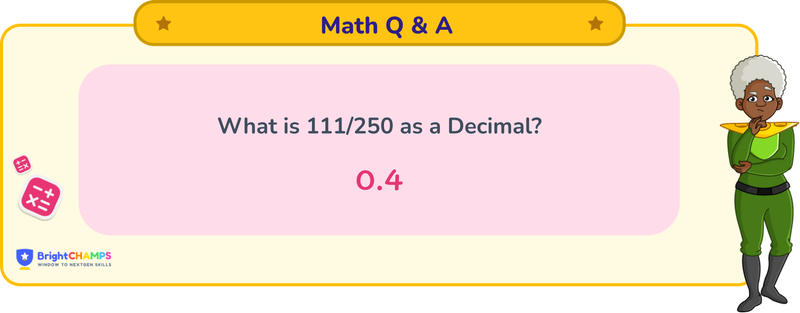Summarize this article:
 253 Learners
253 LearnersLast updated on August 5, 2025
111/250 as a Decimal

This is a simple question on decimal conversion. Firstly, we need to understand fractions and decimals. A fraction represents a part of a whole. It has two parts: the numerator (number on the top), here 111, represents how many parts of the whole are being considered. The denominator (number below), here 250, shows how many parts make up the whole. A decimal is a way to represent a number that is not whole, using a decimal point (.) to separate the whole part from the fractional part. The numbers to the left of the decimal point represent the whole, and those to the right represent the fractional part.

What is 111/250 as a decimal?
 Answer
Answer
111/250 in decimal form is 0.444. It is a terminating decimal, meaning it ends and does not repeat infinitely.
Explanation
To convert 111/250 into a decimal, we use the division method. Let's break down the process step by step:
Step 1: Identify the numerator and denominator. Here, the numerator (111) will be taken as the dividend, and the denominator (250) will be taken as the divisor.
Step 2: Divide 111 by 250. Since 111 is smaller than 250, the quotient starts as a decimal.
Step 3: Perform the division by adding a decimal point and zeros to the right of 111 to continue the division process.
Step 4: 250 fits into 1110 four times, as 250 × 4 = 1000. Write 4 in the quotient and subtract 1000 from 1110 to get 110.
Step 5: Bring down another 0, making it 1100, and divide by 250 again. 250 fits into 1100 four times, as 250 × 4 = 1000. Write 4 in the quotient and subtract 1000 from 1100 to get 100.
Step 6: Bring down another 0, making it 1000. 250 fits into 1000 four times, as 250 × 4 = 1000. Write 4 in the quotient, and you have no remainder.
The answer for 111/250 as a decimal is 0.444.

Important Glossaries for 111/250 as a decimal
- Fraction: A numerical quantity that is not a whole number, representing a part of a whole.
- Decimal: A number that uses the base ten and includes a decimal point to separate the whole part from the fractional part.
- Numerator: The top part of a fraction, indicating how many parts of the whole are being considered.
- Denominator: The bottom part of a fraction, showing how many parts make up a whole.
- Terminating Decimal: A decimal that ends and does not repeat infinitely.




